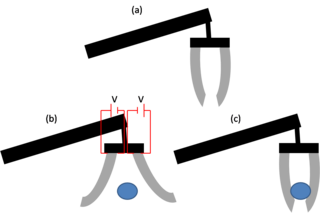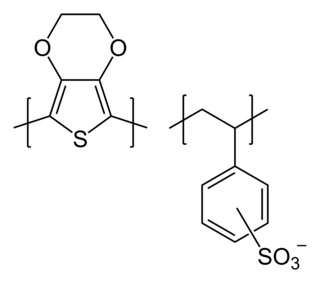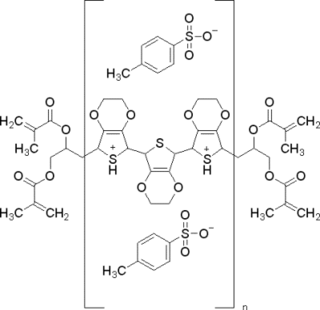Related Research Articles

Organic electronics is a field of materials science concerning the design, synthesis, characterization, and application of organic molecules or polymers that show desirable electronic properties such as conductivity. Unlike conventional inorganic conductors and semiconductors, organic electronic materials are constructed from organic (carbon-based) molecules or polymers using synthetic strategies developed in the context of organic chemistry and polymer chemistry.
Indium tin oxide (ITO) is a ternary composition of indium, tin and oxygen in varying proportions. Depending on the oxygen content, it can be described as either a ceramic or an alloy. Indium tin oxide is typically encountered as an oxygen-saturated composition with a formulation of 74% In, 18% Sn, and 8% O by weight. Oxygen-saturated compositions are so typical that unsaturated compositions are termed oxygen-deficient ITO. It is transparent and colorless in thin layers, while in bulk form it is yellowish to gray. In the infrared region of the spectrum it acts as a metal-like mirror.

Conductive polymers or, more precisely, intrinsically conducting polymers (ICPs) are organic polymers that conduct electricity. Such compounds may have metallic conductivity or can be semiconductors. The biggest advantage of conductive polymers is their processability, mainly by dispersion. Conductive polymers are generally not thermoplastics, i.e., they are not thermoformable. But, like insulating polymers, they are organic materials. They can offer high electrical conductivity but do not show similar mechanical properties to other commercially available polymers. The electrical properties can be fine-tuned using the methods of organic synthesis and by advanced dispersion techniques.

An electroactive polymer (EAP) is a polymer that exhibits a change in size or shape when stimulated by an electric field. The most common applications of this type of material are in actuators and sensors. A typical characteristic property of an EAP is that they will undergo a large amount of deformation while sustaining large forces.

poly(3,4-ethylenedioxythiophene) polystyrene sulfonate (PEDOT:PSS) is a polymer mixture of two ionomers. One component in this mixture is made up of polystyrene sulfonate which is a sulfonated polystyrene. Part of the sulfonyl groups are deprotonated and carry a negative charge. The other component poly(3,4-ethylenedioxythiophene) (PEDOT) is a conjugated polymer and carries positive charges and is based on polythiophene. Together the charged macromolecules form a macromolecular salt.
Metal rubber is a broad, informal name for several conductive plastic polymers with metal ions produced by NanoSonic Inc. in cooperation with Virginia Tech. This self-assembling nanocomposite is flexible and durable to high and low pressures, temperatures, tensions, and most chemical reactions, and retains all of its physical and chemical properties upon being returned to a ground state. NanoSonic’s Metal rubber™ is an electrically conductive and flexible elastomer. It can be mechanically strained to greater than 1000% of its original dimensions while remaining electrically conductive. As Metal rubber can carry data and electrical power and is environmentally rugged, it can be used as a flexible and stretchable electrical conductor in the aerospace/defense, electronics, and bioengineering markets.
Silicone rubber is an elastomer composed of silicone—itself a polymer—containing silicon together with carbon, hydrogen, and oxygen. Silicone rubbers are widely used in industry, and there are multiple formulations. Silicone rubbers are often one- or two-part polymers, and may contain fillers to improve properties or reduce cost.

Carbon nanotubes (CNTs) are cylinders of one or more layers of graphene (lattice). Diameters of single-walled carbon nanotubes (SWNTs) and multi-walled carbon nanotubes (MWNTs) are typically 0.8 to 2 nm and 5 to 20 nm, respectively, although MWNT diameters can exceed 100 nm. CNT lengths range from less than 100 nm to 0.5 m.

Printed electronics is a set of printing methods used to create electrical devices on various substrates. Printing typically uses common printing equipment suitable for defining patterns on material, such as screen printing, flexography, gravure, offset lithography, and inkjet. By electronic-industry standards, these are low-cost processes. Electrically functional electronic or optical inks are deposited on the substrate, creating active or passive devices, such as thin film transistors; capacitors; coils; resistors. Some researchers expect printed electronics to facilitate widespread, very low-cost, low-performance electronics for applications such as flexible displays, smart labels, decorative and animated posters, and active clothing that do not require high performance.
As the world's energy demand continues to grow, the development of more efficient and sustainable technologies for generating and storing energy is becoming increasingly important. According to Dr. Wade Adams from Rice University, energy will be the most pressing problem facing humanity in the next 50 years and nanotechnology has potential to solve this issue. Nanotechnology, a relatively new field of science and engineering, has shown promise to have a significant impact on the energy industry. Nanotechnology is defined as any technology that contains particles with one dimension under 100 nanometers in length. For scale, a single virus particle is about 100 nanometers wide.

Poly(3,4-ethylenedioxythiophene)-tetramethacrylate or PEDOT-TMA is a p-type conducting polymer based on 3,4-ethylenedioxylthiophene or the EDOT monomer. It is a modification of the PEDOT structure. Advantages of this polymer relative to PEDOT are that it is dispersible in organic solvents, and it is non-corrosive. PEDOT-TMA was developed under a contract with the National Science Foundation, and it was first announced publicly on April 12, 2004. The trade name for PEDOT-TMA is Oligotron. PEDOT-TMA was featured in an article entitled "Next Stretch for Plastic Electronics" that appeared in Scientific American in 2004. The U.S. Patent office issued a patent protecting PEDOT-TMA on April 22, 2008.

Solid is one of the four fundamental states of matter. The molecules in a solid are closely packed together and contain the least amount of kinetic energy. A solid is characterized by structural rigidity and resistance to a force applied to the surface. Unlike a liquid, a solid object does not flow to take on the shape of its container, nor does it expand to fill the entire available volume like a gas. The atoms in a solid are bound to each other, either in a regular geometric lattice, or irregularly. Solids cannot be compressed with little pressure whereas gases can be compressed with little pressure because the molecules in a gas are loosely packed.

Transparent conducting films (TCFs) are thin films of optically transparent and electrically conductive material. They are an important component in a number of electronic devices including liquid-crystal displays, OLEDs, touchscreens and photovoltaics. While indium tin oxide (ITO) is the most widely used, alternatives include wider-spectrum transparent conductive oxides (TCOs), conductive polymers, metal grids and random metallic networks, carbon nanotubes (CNT), graphene, nanowire meshes and ultra thin metal films.

A force-sensing resistor is a material whose resistance changes when a force, pressure or mechanical stress is applied. They are also known as force-sensitive resistor and are sometimes referred to by the initialism FSR.
A multi-function material is a composite material. The traditional approach to the development of structures is to address the load-carrying function and other functional requirements separately. Recently, however, there has been increased interest in the development of load-bearing materials and structures which have integral non-load-bearing functions, guided by recent discoveries about how multifunctional biological systems work.
Electronic skin refers to flexible, stretchable and self-healing electronics that are able to mimic functionalities of human or animal skin. The broad class of materials often contain sensing abilities that are intended to reproduce the capabilities of human skin to respond to environmental factors such as changes in heat and pressure.
Potential graphene applications include lightweight, thin, and flexible electric/photonics circuits, solar cells, and various medical, chemical and industrial processes enhanced or enabled by the use of new graphene materials.

Flexible batteries are batteries, both primary and secondary, that are designed to be conformal and flexible, unlike traditional rigid ones. They can maintain their characteristic shape even against continual bending or twisting. The increasing interest in portable and flexible electronics has led to the development of flexible batteries which can be implemented in products such as smart cards, wearable electronics, novelty packaging, flexible displays and transdermal drug delivery patches. The advantages of flexible batteries are their conformability, light weight, and portability, which makes them easy to be implemented in products such as flexible and wearable electronics. Hence efforts are underway to make different flexible power sources including primary and rechargeable batteries with high energy density and good flexibility.

OCSiAl is a global nanotechnology company, the world's largest graphene nanotube manufacturer, conducting its operations worldwide. The OCSiAl headquarters are located in Luxembourg, with several offices in the United States, Europe and Asia.
A stretch sensor is a sensor which can be used to measure deformation and stretching forces such as tension or bending. They are usually made from a material that is itself soft and stretchable.
References
- ↑ Pazhooh, Hadi Najafi; Bagheri, Rouhollah; Adloo, Ali (January 2017). "Fabrication of semi-conductive natural rubber nanocomposites with low copper nanoparticle contents". Polymer. 108: 135–145. doi:10.1016/j.polymer.2016.11.059.
- ↑ Araby, Sherif; Meng, Qingshi; Zhang, Liqun; Kang, Hailan; Majewski, Peter; Tang, Youhong; Ma, Jun (January 2014). "Electrically and thermally conductive elastomer/graphene nanocomposites by solution mixing". Polymer. 55 (1): 201–210. doi:10.1016/j.polymer.2013.11.032.
- ↑ Shimojo, M.; Namiki, A.; Ishikawa, M.; Makino, R.; Mabuchi, K. (October 2004). "A Tactile Sensor Sheet Using Pressure Conductive Rubber With Electrical-Wires Stitched Method". IEEE Sensors Journal. 4 (5): 589–596. Bibcode:2004ISenJ...4..589S. doi:10.1109/JSEN.2004.833152. S2CID 885827.
- ↑ Noh, Jin-Seo (5 April 2016). "Conductive Elastomers for Stretchable Electronics, Sensors and Energy Harvesters". Polymers. 8 (4): 123. doi: 10.3390/polym8040123 . PMC 6432061 . PMID 30979215.
- ↑ Highly stretchable conductive MWCNT–PDMS composite with self-enhanced conductivity https://pubs.rsc.org/en/content/articlelanding/2020/tc/d0tc01735c/unauth#!divAbstract